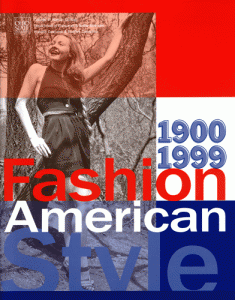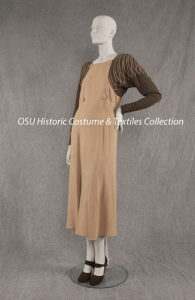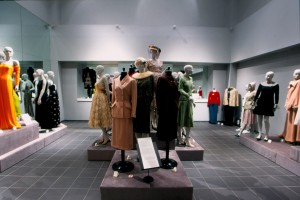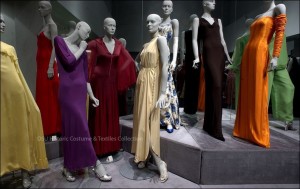October 26, 2001 – May 18, 2002
In the 1900s, after centuries of dependence on Paris fashion dictates, Americans broke free to set their own fashion trends. Fashion American Style: 1900-1999, the new exhibition at the College of Human Ecology, The Ohio State University, documents American’s bold move during the course of the 20th century from formal and constrictive fashions to today’s casual simplicity.
Opening on October 27, 2001, the exhibition will be in the Geraldine Schottenstein Wing of Campbell Hall at 1787 Neil Ave. It is open to the public at no charge and runs through May 18, 2002. Hours are Wednesday through Saturday, 11 a.m. to 4 p.m.
Created by Gayle Strege, curator of the Historic Costume & Textiles Collection, the exhibition will document the rise of American designers of fashion from their first recognized influence during the 1930s, both in the industry and Hollywood, through World War II and the establishment of an American couture industry, to the end of the century when major changes in the garment industry affected apparel designers and design, production, and marketing.
The displays in Fashion American Style will highlight three areas of interest:
- Early dominance by Paris, early influence of Hollywood designers, and World War II (1900-1945)
- American Fashion: Couture, high-end ready-to-wear, and sportswear (1945-1970)
- Fashion industry changes: The end of couture and the rise of licensing and designer ready-to-wear (1970-1999)
The Historic Costume & Textiles Collection is a 9,000 plus item repository of historic artifacts used for education, research, and public outreach. For further information about the exhibit or to check on holiday opening times, contact the College of Human Ecology at The Ohio State University, (614) 292-6761. For tours of 10+ guests, please contact the Historic Costume & Textiles Collection at (614) 292-3090 or e-mail us at strege.2@osu.edu.
Early Reliance on Paris
From the date of America’s founding through the start of the 20th century, American women who wished to be in style bought their clothes in Paris. Rather than design their own fashions, American clothing designers used Paris fashions as models, adapting the styles for the American market. Department store buyers visited the Paris runway shows to memorize details from the new fashions, sketch them, and bring them home for production.
The exhibition features several examples of the early century’s subservience to Paris fashion. Four color sketches of dresses made by Caroline Gershel Davis document the practice of creating knockoffs from the designs presented at Paris couture shows. Garments on display that illustrate this practice include two classic examples of Paris adaptations with intricate details. One is a soft brown crepe Jean Patou adaptation from the 1930s. The calf-length flowing V-necked day dress has attached raglan sleeves that fall to a bishop fullness just below the elbow. Flame and cream fabric inserts make up this fullness before the sleeves narrow to a tight wrist, each ornamented by eight buttons covered in cream and brown fabric.
Hollywood Influences Fashion
American fashion began to gain recognition and assert its place during the 1920s and 1930s. Hollywood helped by providing America and the world with the latest ideals of feminine beauty and glamorous dressing. As women saw their favorite stars in exciting new fashions, the demand for these garments transformed the costumers to designers in their own right.
Gilbert Adrian, the head of costume at Metro Goldwyn Mayer (MGM) from 1928-1941, is credited with creating the signature looks of both Joan Crawford and Greta Garbo. He nurtured a fashion trend when he used gingham to dress Judy Garland as Dorothy in the 1939 version of The Wizard of Oz and for Katherine Hepburn in The Philadelphia Story (1940). Gingham continued to be one of Adrian’s favorite fabrics, as illustrated by the exhibition’s 1950s Adrian wool gingham suit. The tailored jacket features four different sizes of gingham checks, beginning with small checks across the shoulders and graduating to larger checks in cleverly tucked inserts down the front. It is paired with a midcalf straight skirt in matching, medium-sized checks.
Irene followed Adrian as head designer at MGM (1942-1947) but before that was the head of the custom-made department at Bullock’s Wilshire in Beverly Hills. When she left MGM, Irene returned to designing for the custom and ready-to-wear markets. Her sculpted suits were imbued with clever dressmaking details, as illustrated by the exhibition’s striped wool suit by Irene from 1948-55. Unusual seaming creates the perfect fit of the nipped-waist, cuffed-sleeve jacket, making the garment a marvel of perfectly matched black, gray, and brown stripes.
Another Hollywood designer, Jean Louis, originally gained fame while working for Columbia Pictures and Universal. The exhibition displays a light green silk chiffon evening gown trimmed with crystal beads created by Jean Louis for Rita Hayworth. She wore this elegant evening dress in the 1946 movie Gilda, the dark thriller that established her as a star.
Muriel King also started out as a costumer in Hollywood and later became strictly a fashion designer. The exhibition displays a Muriel King evening dress from 1936. The stiff red and black iridescent fabric forms a fitted bodice tapering to a low-cut V back with spaghetti straps. A cummerbund forms horizontal gathers around the midriff.
American Couture: 1947-1970
America’s couture design industry flourished in the years during and after World War II. Some American couture designers trained in Paris, but their style was purely American, adhering to the simple, practical, and casual elements that American women preferred. Americans created top-of-the-line couture to rival any French product.
As professionals, the women couture designers created practical, functional garments suited to their own needs. The exhibition features a late 1940s Valentina dress and jacket that characterizes this trend. The black and red striped wool, woven in a half-herringbone, features a fitted sleeveless dress and matching jacket. The fabric of the jacket is cut so that the attractive black selvage forms a distinctive band at the jacket hem. The jacket’s black velvet collar and its nip and tuck fit is characteristic of the late 1940s New Look attributed to Dior.
The men of America’s early couture were still focused on creating elegance for women. Mainbocher was best known for dressing Wallis Simpson, later the duchess of Windsor. The exhibition features a periwinkle blue Mainbocher evening gown from the 1950s. Made of silk chiffon with pink and gold embroidered ribbon adorning the bodice, the gown is a classic design that is still considered stylish today.
Many of the well-known fashion designers from the second half of the 20th century began during the 1940s and 1950s in the back rooms of department stores or specialty shops, or with manufacturers. Charles James, who trained in Paris, worked for Eve Arden’s custom salon in the 1940s before opening his own salon. The exhibition features an early 1940s black silk evening jacket by Charles James created during his Arden days. A subtle draped and sculpted collar offsets the simple lines of the knee-length jacket. The electric blue lining is stitched by hand.
Ready-to-Wear, a lucrative manufacturing process pioneered by the Americans, ranged from casual sportswear to formal eveningwear. Many designers’ names were never revealed on garment labels, which displayed primarily the manufacturers’ names. Suits by Traina-Norell, Patullo-Jo Copeland, and Hattie Carnegie, 1950s-60s.
High End Ready-to-Wear Takes Hold in the U.S.
Ready-to-Wear, a lucrative manufacturing process pioneered by the Americans, ranged from casual sportswear to formal eveningwear. Many designers’ names were never revealed on garment labels, which displayed primarily the manufacturers’ names. Suits by Traina-Norell, Patullo-Jo Copeland, and Hattie Carnegie, 1950s-60s.
America’s greatest contribution to the fashion industry was ready-to-wear in all styles, from eveningwear to sportswear and separates. Many designers became involved in creating high-end ready-to-wear (RTW) during the 1940s and 1950s. Norman Norell designed first for wholesaler Hattie Carnegie, then partnered with Anthony Traina in 1941, before eventually going on his own in 1960. The exhibition presents a 1950s pink tweed Traina Norell suit. The garment is high end RTW, constructed of textured pink wool tweed with notched-collar jacket.
Luis Estevez originally designed for Grenelle, a manufacturer, before going out on his own. The exhibition’s silk 1950s RTW Luis Estevez evening dress is adorned with blue flowers printed to look woven. The fitted bodice has blue spaghetti straps. The sheath skirt has an elegant bustle-like drape in back and is lined with tulle to enhance its fullness.
Pauline Trigere began her career working for wholesaler Hattie Carnegie, and later went on her own. A 1950s burgundy velvet cocktail dress by Trigere exemplifies the high-end RTW eveningwear of the period. The elegant sleeveless sheath dress has an overlying peplum skirt and is adorned with a beaded belt of diamonds and ruby teardrops. Another of Trigere’s couture caliber designs, a mid-1950s RTW sleeveless silk flowered Trigere dress, has a tucked bodice that demonstrates the designer’s characteristic elegance combined with comfort.
Considered to be the most innovative of American RTW were the designers of sportswear, casual wear, and play clothes who began designing in the 1930s and continued after the war. Of them all, Claire McCardell was considered the most original, and much of her clothing was inexpensive as well. Her easy, flowing, and casual-looking clothes, even for evening, were made for an active lifestyle and exemplified the American Look. The exhibition features a 1948 cotton day dress by Claire McCardell. The deceptively simple RTW dress is made of cotton fabric with a gray ground and four different shades of brown stripes between dividing red stripes. Each narrow stripe is embellished with rows of tiny hearts. The fitted V-neck bodice has flared dolman sleeves; the eight-gore skirt hangs in soft folds. The most striking detail of the dress, however, is the bias cut of the striped fabric, with perfect matching of stripes at each seam to form a continuing W around the waist in both the skirt and bodice.
Tina Leser, another post-War RTW innovator, created the exhibition’s circa 1948 navy blue ensemble. The full velveteen skirt has one deep scalloped tier, plus a matching, long-sleeved pullover knit top with a Peter Pan collar trimmed in satin piping.
New Trends of the 1970s-1999
Many of the specialty and department stores continued their custom salons throughout the 1960s, but the turbulent decade with its radical changes in fashion and the industry proved disastrous for custom dressmaking. The practice of licensing was undermining the cachet of ‘designer’ names. Many custom departments closed at the end of the decade, with only a few lasting until the 1970s before closing.
Consumers started dictating to designers what they would and would not wear beginning in the 1970s. Due to the apparent ‘sameness’ of designs that resulted, designers began to concentrate on their images and the image of their clothes in order to distinguish themselves from each other. Images were cultivated and promoted through increased advertising, and by putting names and logos on clothing.
Design or Marketing? The giants in American Fashion at the end of the twentieth century, Ralph Lauren and Tommy Hilfiger, aren’t so much designers as marketers of a lifestyle image. Both began in menswear and later did women’s fashions. Both offer classic pieces that change very little from year to year. Is this the end of Fashion? Is Sean John following in their successful footsteps?
The exhibition displays an outfit of Ralph Lauren casual wear separates that were characteristic of the 1980s. The blue Oxford cloth woman’s blouse buttons left over right like a man’s shirt, and a Polo logo adorns one sleeve. The blouse is paired with a coordinating plaid skirt. Other branded items on display are by designers Tommy Hilfiger and Sean Jean.
Elegance still existed, but it was all RTW with a new simplicity. Halston’s 1970s red silk chiffon evening gown documents the decade’s trend toward extreme simplicity of line. The V-neck gown with spaghetti straps is bias cut for an elegant drape. The fabric falls from the front-seamed bodice into a full-length skirt with a slight flare created by front and back centered pleats.
By the 1980s, there was no more couture designing except for occasional designers with a small business catering to private clients. Charles Kleibacker, designer emeritus of the College of Human Ecology, began his career in New York designing for manufacturer Nettie Rosenstein. When Rosenstein decided to concentrate on accessories, Kleibacker set up his own business. The exhibition’s pale yellow silk Kleibacker evening gown from the late 1970s is a prime example of the remaining couture in America. The simple sleeveless gown has a placket detail at the neckline and gathers at the shoulders. It is embellished by 44 covered buttons, 8 of them adorning the left shoulder, the other 36 closing the left side of the gown to the lower hip. A spaghetti strap thin tie loops around the waist several times.
The exhibition’s white silk gown with gold and pearl beading by California designer Bob Mackie is an example of America’s late century return to glamorous dressing. Mackie got his start as a costumer for television stars and became known as the designer for the Carol Burnette Show (including the famous drapes dress for the Gone with the Wind sketch) and for Cher’s show. Terre Blair Hamlisch owned this silk chiffon with gathered bodice. The gown’s elaborate gold and pearl beading demonstrates the ability of high-end ready-to-wear to be both glamorous and comfortable.
Throughout the century, American designers have addressed the needs of the American consumer for fashions that were stylish, functional, and economical. Garments created with design simplicity, sometimes humble fabrics, and comfort were manufactured primarily by mass production methods of ready to wear. This often-times casual, no-nonsense, no-frills approach to dressing is recognized as a uniquely American style.
This exhibition was made possible through the generous support of the College of Human Ecology, the Ohio Arts Council, Friends of the Historic Costume & Textiles Collection, and the Department of Consumer and Textile Sciences.







